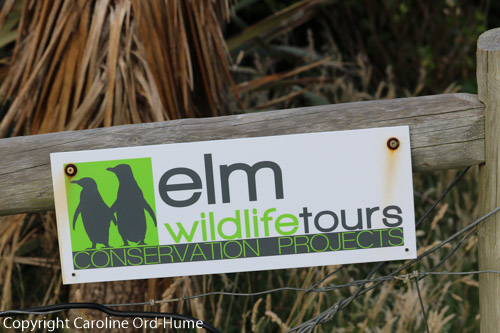Yellow-eyed Penguin hoiho
New Zealand Yellow-eyed Penguins, hoiho, are a rare, threatened, and nationally endangered species. Although I am unsure of any updates to these numbers, estimates put the breeding pairs figure at approximately 1,700, over 600 pairs of which are on the South Island, and nearly 200 pairs on Rakiura/Stewart Island.
Yellow-eyed Penguin Walking up Hill to Nest in the Evening
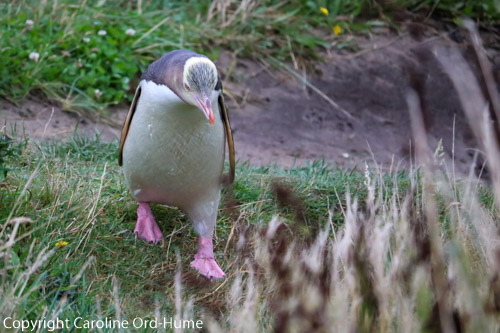
Read more about the distribution of hoiho below.
Yellow-eyed Penguin/hoiho (Megadyptes antipodes) Family: Spheniscidae
Other Names Include: hoiho, hoihoi, yelloweyed penguin, yellow eyed penguin, yellow-crowned penguin, Richdale's penguin
Species Variations: There is genetic distinction between the sub-antarctic and New Zealand mainland populations.
Penguin on Beach After a Day of Fishing, Otago Peninsula
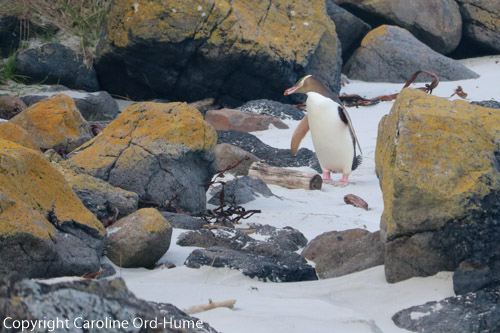
Richdale's penguin M. a. richdalei, is an extinct subspecies that was only on the Chatham Islands. Waitaha penguins are sometimes thought of as a Yellow-eyed Penguin subspecies.
Hoiho on the Beach at Porpoise Bay
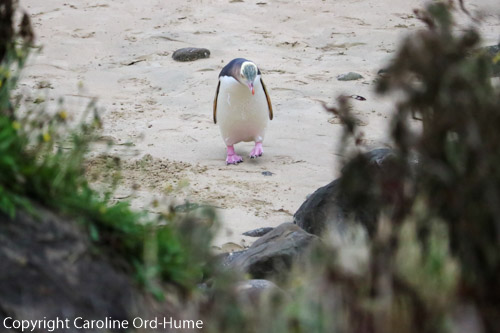
Yellow-eyed Penguin Habitat and Distribution
On the South Island, Yellow-eyed Penguins can be found on Banks Peninsula, the Otago Peninsula, North Otago, the Catlins on the south coast, in the South-east of the South Island.
Other islands where hoiho are found and breed are Stewart Island/Rakiura and surrounding islands, the Auckland Islands, Campbell Island, and Codfish Island/Whenua Hou.
Penguin Feeding Chick Near Nest at Penguin Place, Otago Peninsula
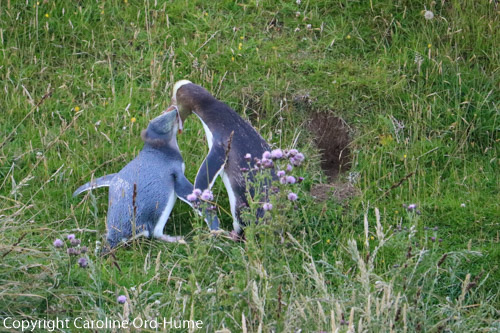
A few have been seen on the North Island in the Bay of Plenty region, the Chatham Islands, and Snares Islands.
Breeding Sites
Yellow-eyed Penguins will breed on partially exposed cliffs, on hill pasture grassland, coastal scrub and forest where there is some wind protection.
Description and Identification
Yellow eyed penguins are easy to identify as they are distinct, with no other species of similarity in size and colour.
Although the male is larger, the male and female penguins look the same, with distinctive yellow eyes and colourful feather patterns around the head and eyes, and colourful brown and cream long bill.
Juvenile birds have paler eye and feather colours on the head and neck. Feet are pink, the front and under wing areas are white, the tail and back are a bluey colour.
See the photos on this page to appreciate the distinctive hoiho colouring.
Penguin on the beach in the afternoon returning from a day out at sea fishing
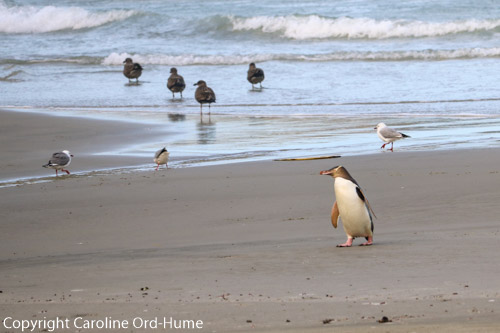
Yellow-eyed Penguin Diet
Hoiho will forage from two to twenty-five kilometres offshore, at diving depths of 40-120 metres to feed on species of fish such as red cod, blue cod, ahuru, opalfish, silversides and sprat, along with crustaceans and cephalopods.
Survival and Conservation of Yellow-eyed Penguins
On Land
The main threats to survival of Yellow-eyed Penguins on land are humans, predators, disease, loss of habitat, temperature extremes causing hypothermia or heat stress.
Penguin chicks survival is threatened by predators introduced by humans such as dogs, cats, stoats, and ferrets.
Penguin Chick Protected by a Conservation Project at Penguin Place, Otago Peninsula
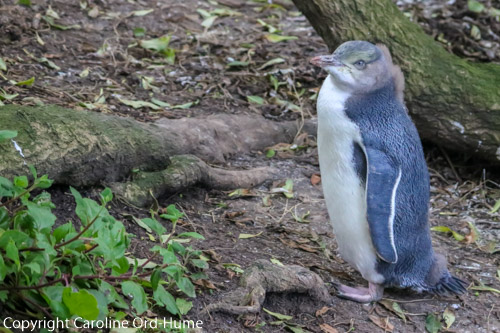
Adult penguin survival is threatened by predatory dogs owned by humans. From that I determine that humans are the biggest threat to penguins due to the animals they have introduced to New Zealand, animals they currently own, or the predators that humans have let free to roam the country, accidentally or on purpose, since they arrived on the islands.
Off Shore
In the waters and open seas the main threats to penguin survival from other wildlife is from seals and sea lions, sharks and barracuda.
And of course, back to the threat from humans through fishing tackle, plastic rubbish, boating, and pollution.
There doesn’t appear to be any current evidence of an impact from recreational or commercial fishing on competing fish stocks that penguins rely on.
Disease
There has been more than one recorded significant number of deaths of penguins in New Zealand. One major die off in 1990 and another one more recently during a breeding season where a disease named as diphtheritic stomatitis infected chicks on land.
Human Disturbance
In locations where penguin viewing tourism is regulated and successfully managed the impact on the successful breeding abilities of the penguins is said to be very little.
However, as these wonderful and rare penguins have become somewhat of a big tourist attraction, in some instances visitor numbers and disturbance has been detrimental to their breeding and survival in locations where there is no regulation or management of visitors.
Conservation
Elm Wildlife Tours Sign at Penguin Conservation Project, nr Dunedin
Penguin Nest Box Conservation Project, Elm Wildlife Tours Dunedin, Otago Peninsula
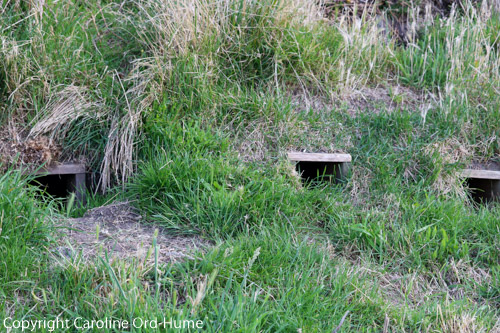
The Department of Conservation (DOC), along with Yellow-eyed Penguin Trust, landowners and communities, manage habitat restoration and protection, and predator control where possible.
Where visitor access is not regulated, information signs and hides to view penguins from without disturbing them have been installed. This attempts to ensure the penguins can breed relatively undisturbed. Educating visitors through information boards and roping off areas of beaches etc. goes some way to achieving a balance of conservation of this species while still permitting people to see the unique wildlife.
Emergency Number
Should you see any New Zealand wildlife being harmed by anyone please call this number and report it immediately.
0800 362 468
New Zealand Wildlife
List of New Zealand Native Birds and List of New Zealand Animals, Land and Marine
References
For further reading and in-depth information these sites are recommended
The Yellow-eyed Penguin Trust
Global Penguin Society - Yellow-eyed Penguin
Department of Conservation - Yellow-eyed Penguin
NZ Birds Online
